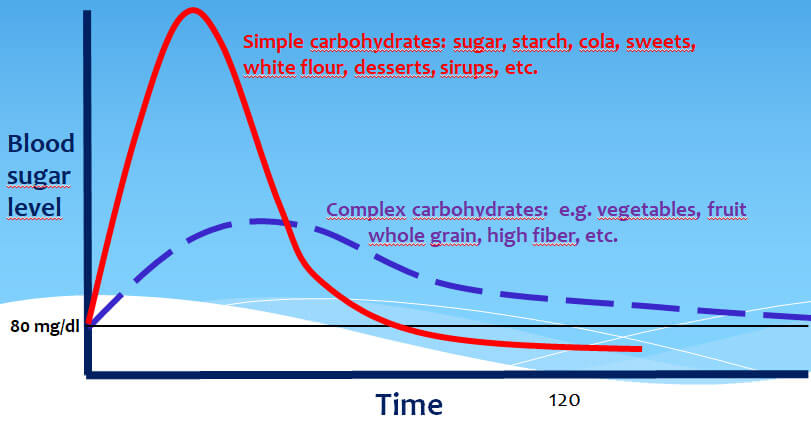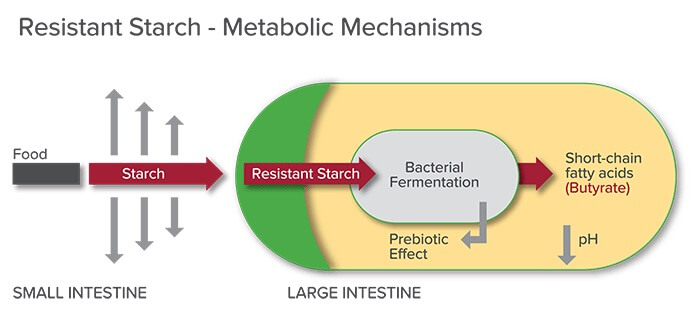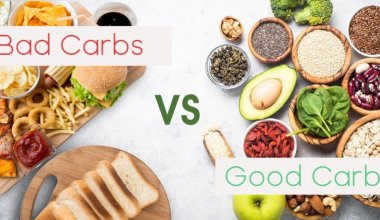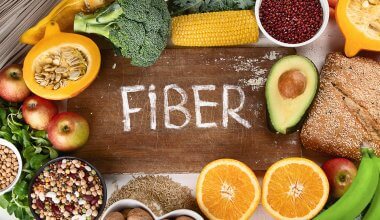In this article, all about resistant starch:
- What Foods are Good Sources of Resistant Starch?
- A Tale of Two Starches
- Gut Health Benefits: The Science Behind the Starch
- Resistant Starch Is the Food Your Body — And Your Gut — Needs
- Tracking the Journey
- Where Resistant Starch Comes From — And How You Can Get More of It
- Making Resistant Starch Part of Your Daily Routine
- Closing the Resistant Starch Gap in Our Diets
What if I told you there is a natural food ingredient found in plants that:
- Can dramatically improve your health across a wide range of conditions (and surprise… It’s not CBD)?!
- Is very well-studied and was a mainstay in our ancestors’ diets, but is almost completely absent from western diets today?
- Is a way to naturally strengthen and balance your all-important immune system?
- Is actually a type of carb?!
This plant-based superfood is called Resistant Starch.
That’s right — this powerful food ingredient is a starch, a type of carbohydrate! Who said there’s no such thing as good carbs?
If you’re like me, you’ve likely never heard of resistant starch before and probably think this all seems hard to believe. It wasn’t until I dug into the clinical research and explored the history of resistant starch that I began to fully appreciate the significant potential of this plant-based ingredient to have a transformative impact on some really prevalent health conditions.
After completing my research, it became apparent to me how significantly so many people could benefit by incorporating resistant starch into their diets on a regular basis.
THIS INFORMATION NEEDS TO BE SHARED!
So it has become my personal mission to increase awareness of this amazing ingredient and make it WAY easier to get a lot more resistant starch into our diets.
I spent over a year working with a team of food scientists, physicians, and nutritionists to create breakthrough products that make resistant starch accessible to everyone. My team and I have also compiled lots of helpful information about resistant starch to increase awareness and make it a household term.
This article provides a practical overview of just about everything you need to know about resistant starch, and is based on findings from over 200 clinical studies and research papers.
Let’s dive in and you’ll see why I’m so enthralled by this amazing food ingredient and excited to introduce it to you!
What Foods are Good Sources of Resistant Starch?
Let’s start with a basic question related to your diet. How many of the following foods — all of which contain resistant starch — do you regularly get in your diet?

- Green bananas or plantains
- Uncooked rolled oats
- High-amylose maize or corn starch
- High-amylose potato starch
- Cooked and cooled potatoes or rice
Probably not too many, right? It’s completely understandable if you’re just learning about resistant starch for the first time. Most of us aren’t very familiar with this superpowered starch primarily because we don’t get much of it in modern western diets. Which is unfortunate because nearly everyone of us struggles with at least one health issue that can be improved by getting more resistant starch in our diet, including:
- carrying around a few extra pounds
- elevated blood sugar levels
- digestive issues
- poor immune system response
- high cholesterol levels
- too much unhealthy snacking between meals
- low energy levels
Believe it or not, more than 200 clinical studies have shown that resistant starch has powerful and unique health-promoting properties affecting so many conditions even though this food ingredient has been largely ignored until recently! This was mind-blowing to me.
Resistant starch has been scientifically proven to reduce inflammation (1), lower blood sugar levels (2), improve insulin sensitivity (3), reduce appetite (4), strengthen immunity, aid digestion (5, 6), prevent constipation (5), decrease cholesterol (7) and even lower your risk of multiple chronic diseases, just to name a few.
But what exactly is resistant starch and how does it work? I’ll cover that next.
A Tale of Two Starches
Resistant starch is a unique and powerful type of prebiotic fiber — a type of dietary fiber that feeds the beneficial bacteria in your gut — found in certain types of carbohydrates.
It is called resistant starch because it resists digestion – by you at least. Instead it bypasses your normal digestive process and makes it all the way to your large intestine (aka gut) where it has its magical prebiotic effect feeding your beneficial bacteria.
Most carbs work against you by breaking down into glucose and raising blood sugar. Resistant starch actually works for you by actively reducing blood sugar spikes and crashes (2), reducing appetite (especially when combined with protein and other prebiotic fibers), and improving insulin sensitivity (3)— your body’s natural ability to effectively metabolize sugar over the long term.
Let’s take a closer look at the difference between traditional starches and resistant starch.
Most of the carbohydrates in our diet are made up of starch. Traditional starches break down into glucose as a source of short-term energy, raising your blood sugar levels and telling your body to produce insulin.

Over time as you consume more and more traditional starch, your body becomes less sensitive to increasing blood sugar levels and the less insulin you produce. This is why traditional starches get a well-deserved bad rap among many health professionals and nutrition experts, and should be consumed in moderation.
As for resistant starch, the hero of this story? It has the power to “resist” normal digestion — it’s not digested by the small intestine, and is only digested once it reaches your lower gut by the good bacteria in the gut microbiome. That means resistant starch skips the step of breaking down into glucose altogether and doesn’t spike your blood sugar.
Resistant starches also have these additional superpowers:
- They’re much lower in calories than traditional starches.
- They don’t count toward your NET CARB intake. Any nondigestible carbohydrates including fibers are subtracted from total carbs when calculating net carbs. So only carbs that your body digests and uses for near-term energy count toward your net carbs.
- They help keep you full longer because they are digested so slowly in your gut, especially when combined with protein and other prebiotic fibers!
- In addition to keeping your blood sugar levels stabilized in the near term, they have also been shown to reduce average blood sugar levels and improve insulin sensitivity over the long term!
Gut Health Benefits: The Science Behind the Starch
Resistant starch has incredible potential for improving health across a wide range of conditions, and has been validated by more than 200 clinical studies.
Are you interested in reducing blood sugar levels over the long term?
One of the most well-documented and studied health benefits of resistant starch is its ability to improve insulin sensitivity. (3, 8, 9) Insulin is the hormone produced by the pancreas that regulates blood sugar concentrations in your body. Insulin sensitivity measures how responsive your body is to the effects of insulin and its ability to keep your blood sugar in check over time. Studies have shown a 33-50% improvement in insulin after four weeks of including 15-30 grams of resistant starch daily. (9)

So by regularly incorporating more resistant starch into your diet, you can improve insulin sensitivity and actually reduce your average blood sugar levels over time — which is called A1C levels. (10) In case you’re not familiar with A1C, it measures your average blood sugar levels over a three-month period. A1C is widely considered the gold standard for determining whether someone has normal blood sugar, is prediabetic, or diabetic. (11)
The impact of resistant starch on long-term blood sugar levels is truly significant and groundbreaking. (3) To put this in perspective, it is estimated that 40% of the US population falls outside of the “normal blood sugar” range. This is a major reason why I’m so passionate about resistant starch and its potential impact on public health. Practically all of us have been affected by health issues related to blood sugar management — either directly or within our families and loved ones.
Therefore reducing A1C levels by incorporating resistant starch into your diet can truly transform your health naturally by helping get your blood sugar under better control.
How often do you feel tired shortly after eating, or hungry again just hours after a meal?
Well, here’s the great news: you actually don’t have to wait several months to see the benefits of consuming resistant starch. Instead, you can start feeling the benefits immediately, as it helps your body avoid blood sugar spikes and crashes right away. (12)
Resistant starch helps keep your blood sugar balanced even when it’s time for your next meal, increasing your feeling of fullness and reducing overall appetite when combined with protein and other prebiotic fibers. There aren’t too many foods that can do this. But resistant starch can because it’s digested very slowly in your gut, keeping you feeling full for longer.
Resistant Starch Is the Food Your Body — And Your Gut — Needs
Do you know about the trillions of microorganisms living in your gut right now? While most people think about bacteria as something they want to avoid, we all have an invisible community of thousands of different species of bacteria living inside our large intestines. This community is called the gut microbiome and it’s the absolute epicenter of our health. (13)
These trillions of bacteria play a pivotal role in your health by aiding digestion, metabolism, and immune function, among others. (14)
Resistant starch falls into a class of foods called prebiotics — not to be confused with probiotics. While probiotics are live cultures of bacteria that are intended to help maintain and improve the populations of good bacteria in our body, prebiotics are the fuel for the good bacteria in our gut. (15, 16)
Healthy bacteria simply cannot survive without prebiotics to keep them thriving and strong. Having the right kind of prebiotic fiber — and the right amount — in our daily diet is a more reliable and effective way to improve your gut health vs. taking a daily probiotic and hoping it will actually make it to your gut and colonize there.
Tracking the Journey
After resistant starch “resists” digestion and bypasses the small intestine, it completes its journey in the gut where it feeds the friendly bacteria. This process is called ‘fermentation’. Just think of resistant starch as the favorite food of these beneficial bacteria to help them grow and proliferate.(5, 17)

As they feed on resistant starch, the good bacteria produce a variety of super-important small molecules called short-chain fatty acids (SCFAs). (18) These SCFAs are special because they have been shown through scientific research to be the essential drivers of clinically-proven benefits for our health and well-being.
A few examples of SCFAs are acetate, propionate and butyrate. The most notable of these SCFAs is butyrate, which is the powerful preferred food of the cells that form the lining on your gut wall. When butyrate is produced in the gut, it sends out signals to several systems in your body that lead to reduced inflammation, healthy intestinal walls and improved digestion, regulated blood sugar and insulin levels, improved heart health, improved immune health, improved mental health, and more. The studied health benefits of butyrate are vast and have incredible potential (18, 19, 20).
Can This Also Affect Immunity?
One of the most well-studied and crucial benefits of these superpowered SCFAs — especially given the current state of the world — is their beneficial impact on your immune system. This makes sense when you consider that up to 80% of your body’s immune cells actually reside in your gut. Research has shown that SCFAs are the primary method through which your gut influences and communicates with your immune system, helping it operate at its peak and reducing your risk of infection.
Where Resistant Starch Comes From — And How You Can Get More of It
Because resistant starch “resists” digestion, it’s really a superpowered dietary fiber that can be used as “food” by the good bacteria that live inside our gut.
Given the abundance of information on its beneficial, gut-enhancing properties, recently the FDA officially classified resistant starch as a dietary fiber based on emerging scientific evidence around its potential especially on its health benefits on blood sugar management:
So how can you specifically get more resistant starch to start improving health in these key areas of the body?
For starters, clinical studies and evolutionary research tell us that everyone can benefit from 10-30 grams of resistant starch per day given the broad benefits on gut health and overall health. That said, it can be difficult getting enough in our diets — especially given the “healthy” amount of processed foods in most of our western diets (pun intended).
So I’ll break down the different ways you can start getting more resistant starch into your diet.
Resistant starch falls into four main categories: (21)
- Type 1: Found in grains, seeds, beans and other legumes
- Type 2: Found in green (unripe) bananas or plantains, raw potatoes, and high-amylose maize (corn)
- Type 3: Converted from digestible starches when certain foods like potatoes and rice are cooked and then cooled
- Type 4: Man-made via a chemical process
Making Resistant Starch Part of Your Daily Routine
Despite the well-documented health benefits, this superfood continues to elude us.
Why? It’s simply hard to find foods in our modern diets with high levels of resistant starch.
Back in the day, getting 30 to 50 grams of daily resistant starch was easy — our ancestors ate intact whole grains, beans, green bananas, and raw starchy foods. Fiber-rich beans and legumes were primary sources of protein.
Our diets today look vastly different from our ancestors. Today’s Western diets are high in processed foods (including way too much fast food) which are low in fiber. Most grains available to us are highly processed or cooked, which removes much of the resistant starch. Unfortunately, fiber like resistant starch has been largely stripped from our fruits and vegetables over the years as crops have been bred to be larger and tastier with higher sugar content and lower fiber.
Given all of this, most of us today get less than five daily grams of resistant starch every day. (21) This is a far cry from the levels of resistant starch consumed by our ancestors and proven by clinical studies to be beneficial for our health.

One way to get some additional resistant starch in your diet is by changing how you prepare your starchy foods such as potatoes and rice. However, to get more of it you need to cool them after cooking and eat them cold (or reheated at low temperatures <175°F) to maintain those levels. (22) The cooking and cooling process alters the chemical structure of potatoes and rice to increase their resistant starch content.
You can also add sources of resistant starch into your diet like white beans, lentils and other legumes, cashews, oats, barley, green bananas and plantains, and raw potato starch. Here’s a handy list of foods that contain resistant starch. Unfortunately most of these food sources don’t contain high levels of resistant starch, so you’ll need to consume quite a bit to come close to the levels our ancestors benefitted from.
I’ll admit — it can be tricky to work this vital nutrient into your diet. To ensure you’re getting the recommended daily amount for optimal health and blood sugar control (30-40 grams) you will most likely need to supplement your diet.
That’s the core philosophy behind Muniq and why I spent more than years researching and perfecting our formulation of prebiotic fiber powered by resistant starch.
Closing the Resistant Starch Gap in Our Diets
I’ve spent the majority of my career in the field of health and nutrition. Yet, I have never encountered such a powerhouse ingredient as resistant starch — undeniably backed by clinically proven health benefits but not broadly accessible in a typical diet. The body of clinical research compiled on resistant starch over the last 10-15 years is beyond compelling, proving its pervasive positive health benefits. However, there remains a gap in terms of ways to get significant levels of resistant starch into our diets through easily accessible food sources.
My team and I identified high-quality concentrated sources of resistant starch from plants to formulate our shake. We are making it easy, convenient, and even enjoyable for you to get an efficacious dose of prebiotic resistant starch into your everyday diet. Each Muniq shake provides 15 grams of resistant starch and other synergistic prebiotic fiber to feed the good bacteria in your gut. Muniq is also designed as a complete and balanced nutritional shake that can keep you full for up to four hours.

Muniq makes it easy to make up for the lack of resistant starch (and fiber in general) in our western diets. Plus, it’s a foolproof, dead-simple way to make sure you’re taking advantage of this super starch with five delicious flavors that are easy to make and take on the go.
When food works for you, the benefits are endless. From regulating blood sugar to helping you keep the weight off to promoting heart health, prebiotic resistant starch is the natural food that the good bacteria in your gut crave.
The best part is, you don’t have to change your entire routine to introduce this secret health weapon into your diet every day. Muniq was designed to conveniently fit into your everyday life. At Muniq we are all about empowering you to take control of your health through nutrition and helping you live vibrantly.







